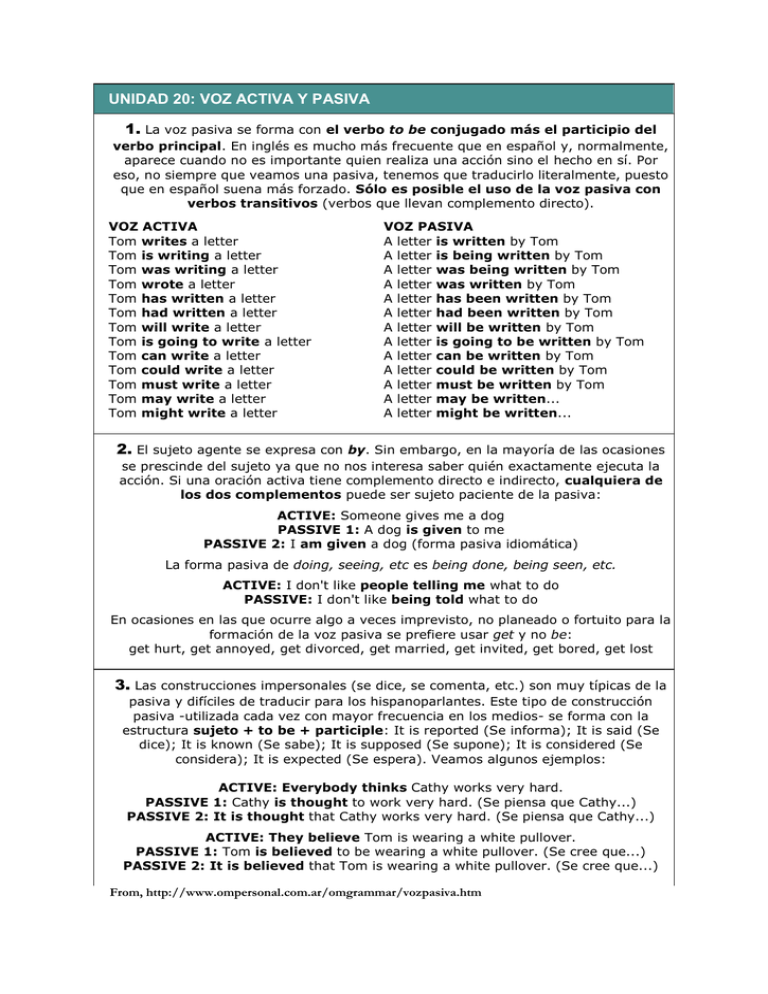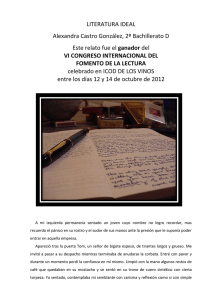unit 10 - passive vo... - Horarios de los centros asociados de la uned
Anuncio

UNIDAD 20: VOZ ACTIVA Y PASIVA 1. La voz pasiva se forma con el verbo to be conjugado más el participio del verbo principal. En inglés es mucho más frecuente que en español y, normalmente, aparece cuando no es importante quien realiza una acción sino el hecho en sí. Por eso, no siempre que veamos una pasiva, tenemos que traducirlo literalmente, puesto que en español suena más forzado. Sólo es posible el uso de la voz pasiva con verbos transitivos (verbos que llevan complemento directo). VOZ ACTIVA Tom writes a letter Tom is writing a letter Tom was writing a letter Tom wrote a letter Tom has written a letter Tom had written a letter Tom will write a letter Tom is going to write a letter Tom can write a letter Tom could write a letter Tom must write a letter Tom may write a letter Tom might write a letter VOZ PASIVA A letter is written by Tom A letter is being written by Tom A letter was being written by Tom A letter was written by Tom A letter has been written by Tom A letter had been written by Tom A letter will be written by Tom A letter is going to be written by Tom A letter can be written by Tom A letter could be written by Tom A letter must be written by Tom A letter may be written... A letter might be written... 2. El sujeto agente se expresa con by. Sin embargo, en la mayoría de las ocasiones se prescinde del sujeto ya que no nos interesa saber quién exactamente ejecuta la acción. Si una oración activa tiene complemento directo e indirecto, cualquiera de los dos complementos puede ser sujeto paciente de la pasiva: ACTIVE: Someone gives me a dog PASSIVE 1: A dog is given to me PASSIVE 2: I am given a dog (forma pasiva idiomática) La forma pasiva de doing, seeing, etc es being done, being seen, etc. ACTIVE: I don't like people telling me what to do PASSIVE: I don't like being told what to do En ocasiones en las que ocurre algo a veces imprevisto, no planeado o fortuito para la formación de la voz pasiva se prefiere usar get y no be: get hurt, get annoyed, get divorced, get married, get invited, get bored, get lost 3. Las construcciones impersonales (se dice, se comenta, etc.) son muy típicas de la pasiva y difíciles de traducir para los hispanoparlantes. Este tipo de construcción pasiva -utilizada cada vez con mayor frecuencia en los medios- se forma con la estructura sujeto + to be + participle: It is reported (Se informa); It is said (Se dice); It is known (Se sabe); It is supposed (Se supone); It is considered (Se considera); It is expected (Se espera). Veamos algunos ejemplos: ACTIVE: Everybody thinks Cathy works very hard. PASSIVE 1: Cathy is thought to work very hard. (Se piensa que Cathy...) PASSIVE 2: It is thought that Cathy works very hard. (Se piensa que Cathy...) ACTIVE: They believe Tom is wearing a white pullover. PASSIVE 1: Tom is believed to be wearing a white pullover. (Se cree que...) PASSIVE 2: It is believed that Tom is wearing a white pullover. (Se cree que...) From, http://www.ompersonal.com.ar/omgrammar/vozpasiva.htm




